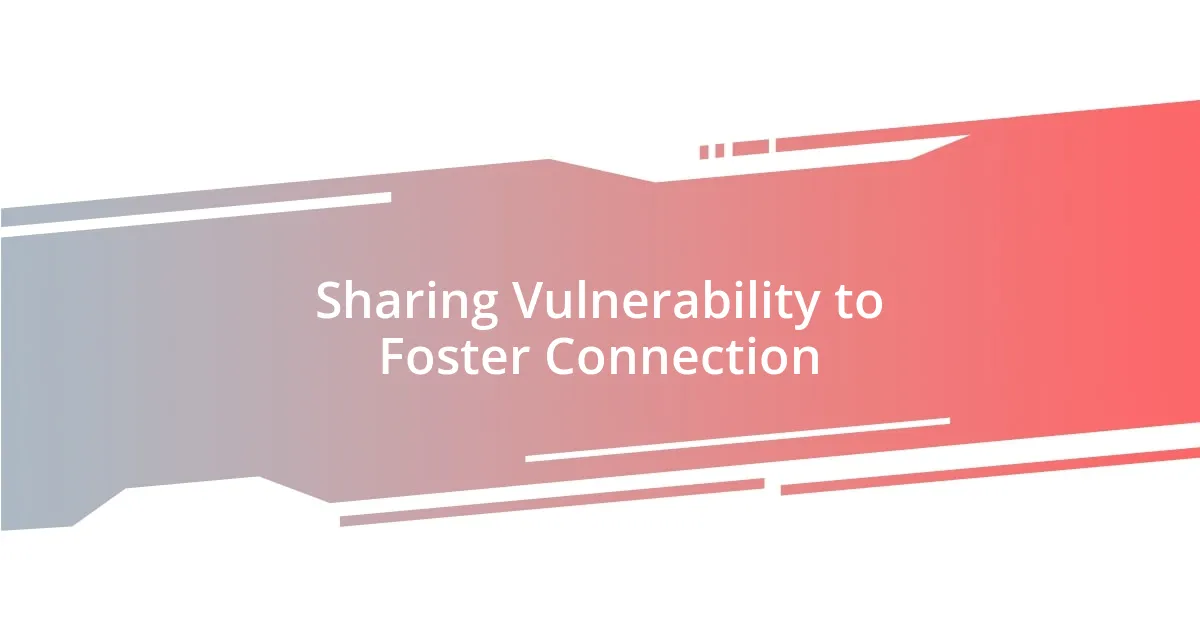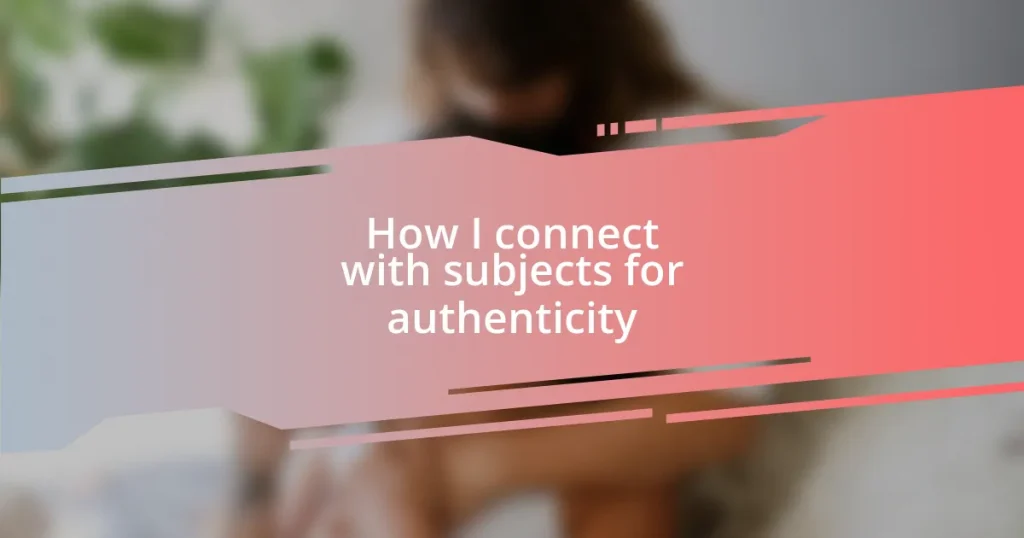Key takeaways:
- Authenticity in connections involves vulnerability, where sharing personal struggles fosters deeper bonds and trust.
- Techniques such as active listening, mirroring, and allowing silence are crucial for engaging in meaningful conversations.
- Sharing one’s vulnerabilities can create a safe space for others to open up, leading to more genuine interactions.
- Maintaining authenticity over time demands ongoing self-reflection and adaptability to nurture evolving relationships.

Understanding Authenticity in Connections
Authenticity in connections often boils down to vulnerability. I remember a time when I opened up about my struggles with self-doubt during a group discussion. The deep silence that followed was palpable, but then others began to share their own challenges. It struck me how this shared honesty not only deepened our bond but made our conversations feel genuine and meaningful.
When I think about authentic connections, I often ask myself: What does it truly mean to be real with someone? It’s not just about sharing surface-level details; it’s about revealing our true selves, fears, and aspirations. I’ve found that when I drop my guard and allow others to see my imperfections, it invites them to do the same, creating a powerful sense of trust.
In my experience, authenticity requires presence. During one memorable conversation with a friend, I realized I was fully engaged, putting my phone aside and listening intently. It was in that moment—where distractions faded—that we uncovered layers of our emotions and thoughts that we had never shared before. Isn’t it fascinating how simply being present can transform a mundane chat into a profound exchange?

Building Trust with Subjects
Building trust with subjects is a nuanced process. When I first began interviewing for a project, I discovered that showing genuine interest in their stories made a world of difference. I remember sitting across from a subject who appeared hesitant at first. As I leaned in, actively nodding and reflecting on their words, they began to relax. That simple act of showing I cared allowed them to share details they initially held back, transforming our conversation.
I’ve often felt that trust can be fragile, like a delicate glass sculpture. One particularly revealing interview comes to mind. A subject started to speak about a painful memory, but instead of rushing to change the subject, I allowed the silence to linger. Moments later, they confided in me about a loss that deeply affected their life. This taught me that giving space can sometimes invite openness, fostering a connection where subjects feel safe enough to reveal their truths.
Building trust hinges on mutual respect. I often remind myself that my role is not just to extract stories but to honor the vulnerability of those I engage with. In a recent conversation, I shared my own challenges first, which encouraged the subject to reciprocate. It struck me how offering my own authenticity helped to level the playing field, creating an atmosphere where vulnerability felt comfortable rather than intimidating.
| Trust-Building Techniques | Description |
|---|---|
| Active Listening | Give full attention and validate the subject’s feelings. |
| Sharing Personal Experiences | Encourage openness by sharing your own relevant stories. |
| Allowing Silence | Use pauses to give subjects space to reflect and share. |

Techniques for Engagement in Conversations
Engaging in authentic conversations often boils down to a blend of techniques that foster connection. One technique that I find particularly effective is mirroring. Once, while speaking to a colleague about a challenging project, I noticed how adjusting my tone and body language to match their energy created a more relaxed atmosphere. This subtle synchronization not only made them feel heard but also encouraged a deeper conversation about their fears relating to the project.
Practical techniques that I’ve embraced include:
- Eye Contact: Maintaining eye contact shows your genuine interest, making the subject feel valued.
- Open-Ended Questions: These types of questions invite deeper responses and keep the dialogue flowing.
- Empathic Responses: Reflecting back what others share, such as, “That sounds really tough,” demonstrates understanding and encourages them to delve further.
In my experience, exploring personal interests has also enriched conversations. For example, I once asked a friend about their hobby of pottery, and as they shared their passion, I realized how my curiosity not only kept them engaged but also revealed hidden layers of their personality. Invoking deeper dialogues about passions often leads to unexpected insights and stronger connections.

Active Listening for Deeper Insights
Active listening is an art that transforms ordinary conversations into profound exchanges. I vividly recall an interview where, instead of just hearing, I tuned in completely to my subject’s narrative. As they unfolded their story, I found myself leaning in, absorbing not just their words but their emotions. It was in that moment of pure focus that I realized how their voice trembled with the weight of experience, compelling me to ask questions that resonated more deeply.
I often wonder: how many moments do we miss when we’re not fully present? One afternoon, during a chat with someone about their career journey, I discovered that they hesitated before sharing their biggest setback. By pausing and maintaining steady eye contact, I encouraged them to explore that painful chapter. The relief on their face as they recounted their struggle felt like a gift—one I received not by speaking, but by creating a space where they could unravel their truth.
The depth of insight I gain from active listening is immeasurable. It reminds me of a time when I simply repeated a phrase they said with curiosity, asking, “Could you tell me more about that?” The floodgates of emotion opened. I realized that listening is not just about absorbing information; it’s about validating experiences. It’s in those moments that I find subjects feel empowered to delve into the threads of their lives, revealing richer narratives that I could never have accessed had I rushed the conversation.

Sharing Vulnerability to Foster Connection
Sharing vulnerability is a powerful tool for building connection. I remember a particular instance when I opened up about my own struggles with anxiety during a conversation with a friend. As soon as I shared my experience, I noticed a shift in their demeanor—a warmth in their eyes, making it clear that my honesty encouraged them to reveal their own challenges. It’s interesting how being vulnerable creates a safe space for others; it’s almost as if we give them permission to be real too.
There’s something profoundly authentic about admitting our imperfections. One time, while discussing a joint project, I confessed my fear of failure and how it often paralyzes my creativity. To my surprise, my colleague shared a similar sentiment, and that acknowledgment sparked a much deeper dialogue. Isn’t it fascinating how vulnerability can bridge gaps between people? Instead of standing on opposite sides, we suddenly found ourselves on common ground, united by our shared fears and aspirations.
Sometimes, I reflect on how vulnerability enriches not just conversations, but relationships. I’ve found that when I bravely share my fears or insecurities, my connection with others deepens. With each shared story, I believe we dismantle the barriers of pretense, inviting authenticity to flourish. What I’ve learned is that exposing our authentic selves allows others to do the same, leading to richer, more meaningful interactions.

Maintaining Authenticity Over Time
Maintaining authenticity over time requires consistent self-reflection and a genuine commitment to the subjects’ experiences. For instance, I’ve noticed that after several conversations with one particular subject, I started to feel less anxious about uncovering their truths. This comfort pushed me to revisit previous topics and ask probing questions that drew out deeper layers of their story. I often ask myself: How can I ensure my connection remains true and meaningful?
I recall a project spanning several months where I checked in regularly with a participant. Each meeting allowed me to witness their evolving perspective on a challenging issue they faced. This ongoing dialogue not only built trust but also enriched the narrative we were creating together. I realized that maintaining authenticity isn’t a one-time effort; it’s a journey that requires me to adapt and stay engaged.
There was a moment during one of those check-ins when my subject shared their feelings about a recent setback. Their voice quivered with vulnerability, and I felt a rush of empathy wash over me. In that instance, I understood how crucial it was to be flexible and responsive as our conversations progressed. Isn’t it fascinating how authenticity can weave through the fabric of time, becoming stronger with each shared experience? By continually nurturing these relationships, I believe we can foster a lasting authenticity that’s both rewarding for us and our subjects.















